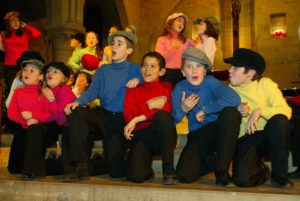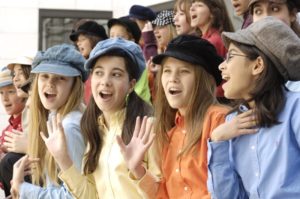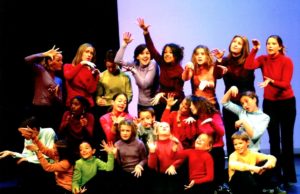Movement with Children’s Choirs
By Scott Alan Prouty, conductor and teacher
Many teachers, as well as fellow conductors, ask me why I favor movement when working with children’s choirs. As an American growing up in the United States, I’ve always associated choral singing with movement, whether it is simple body exercises to warm up the choir or an intricate piece of choreography used to showcase a Broadway medley. Having lived and worked in Paris for the last 25 years, I am now more than ever convinced that an integral part of the training of a children’s choir is the use of movement. Following are some of the explanations I give to choral teachers who participate in my workshops at the Paris Opera:
- Choral singing can often inhibit and even go against the natural energy and spontaneity of a child…« sit up straight, keep your feet firmly placed on the floor, breathe deeply, don’t move your shoulders, look at me when I’m conducting, articulate, concentrate, think about the phrasing, don’t move your hands, don’t slouch, don’t talk, smile » etc. Using games and movement can help the children learn to stand proudly and confidently like a « singer » or an « artist » without feeling constrained. I hate to see children singing in a choir without any soul, without any life or energy. The key is getting the children to sing freely and with joy even though they are in a static choral position. Movement, exercises, and games can help them cultivate this inner energy and lose their inhibitions.
- For the past 20 years, I have been the musical expression and singing teacher at the Ballet School of the Paris Opera and have always been amazed at how well the ballet students sing without any formal vocal training. Being dancers, they have terrific posture and perfect alignment. Being children, they have an incredible enthusiasm and a contagious « joie de vivre » (joy of living). This combination allows them to sing freely with a very natural and well-placed voice. My experience with these young dancers has convinced me that good posture; alignment and a relaxed body are the keys to good choral singing.
- I feel that 80% of vocal technique with a children’s choir is getting the young singers to feel free, relaxed, uninhibited and in touch with their own bodies. The present generation of kids live in a world filled with incredible inventions, images, gadgets and wonders of technology, but they are less and less in touch with their own bodies. They play fewer sports; they remain behind a computer instead of playing outside riding on their bikes, climbing trees, or playing soccer. We, therefore, as choral conductors, must teach children how to feel good about themselves and teach them to rediscover their own bodies and understand how their body works. How to extend their arms, how to wiggle their toes, how to spread their fingers, and how to structure their improvised movements.
- Children tend not to really listen to the words of what they are singing, especially in France, since 95% of the music they listen to is American. Having the children improvise gestures to a certain piece helps the choir members to really focus on the words and bring the text to life. I sometimes have the kids perform their own gestures in a concert or simply use this exercise in a rehearsal to work on the text.
- I work a lot on how to enter and exit a concert stage and how to find one’s place in the choir on stage easily without effort. Every stage movement must be motivated. I often tell the children to smile with their eyes and try to communicate and even « flirt » with the audience. I work a lot on how to walk and how to move on stage with energy. I even talk about feeling energy in each finger, in each toe, in the knees…even in the hair! I play a lot of conducting games so that the children not only enjoy watching me, but also feel the importance of following the conductor.

- I tell my students that the song starts 10 seconds before the piano introduction and ends 10 seconds after the last note. The goal is to not let the energy die down in between each piece. I also tell my young singers that it’s very important not to let the energy deflate at the end of the song.
- Movement is terrific in helping children sing warm-up exercises or when working on a tough phrase. I’ll never forget that when I was a high school student, I was able to sing a High B without any effort when performing in a show because I was dancing or moving and, therefore, not focused on the difficulty of my vocal technique. Yet, during a recital or a choral concert, I had trouble getting up to a High F because I was immobile and completely focused on vocal technique. Remembering this lesson, I now use gestures and movement to help children sing the upper notes with freedom and without strain. Once they see and feel how easy the higher notes are to sing, I then get them to feel good about singing the same notes in a static position without the movement. I always remind my young singers that great vocal technique should appear invisible to the audience.
- Using choreography is a fantastic tool for getting the choir to let go. Learning movement, coordination and gestures and trying to sing beautifully at the same time, is a huge challenge. BUT, it is very important that the choreography help the choir to sing well and not go against the phrasing or the sense of the music.
- I sometimes do an entire concert of sacred music without any movement, but I use movement to loosen up the choir during rehearsals and to get them to sing the music freely and musically. It’s very important to start each rehearsal with a series of exercises to help the students loosen up and forget about their day at school or their problems at home. Corporal exercises, vocal and rhythmic games help the « normal » everyday student transform into a singer or more importantly into an « artist ».
- How do I start teaching movement to a choir? I always start with simple exercises where they imitate my movement. I get them to jump around, massage the other students, repeat fun sounds, and do echo patterns. I have them move to music, getting them to let go, be creative and try to interpret the music without feeling intimidated. I teach them simple dance steps to a canon, making sure that they do each step perfectly with beautiful intonation. The key is to teach the children to move WITHOUT hurting the beauty of the singing. I ask the students to improvise gestures to a song with creative lyrics, forcing them to think and find expressive ways of bringing the text to life. I work on mime exercises and teach the children how to exaggerate the movement. WARNING: as a conductor of children’s choirs, one must be willing to let go and not be afraid to move and uninhibited with the children.
- I always tell my conducting students that children learn by imitation and not by words. As a conductor, we must set the example by having perfect posture, singing freely, moving freely with expression and enthusiasm. To me, a conductor who loves singing and loves to move will inspire his choir to let go and be wonderful.
I personally feel that any great children’s choir should be very versatile and able to sing any repertoire and any style of music. Why not sing the Pergolesi Stabat Mater in the same concert as a gospel song with movement? What’s wrong with working on a magnificent piece by John Rutter at the same time as a choreographed medley of West Side Story? The important thing as choral educators is that we teach children to love singing and to sing well. Our goal is for children to learn to sing freely and generously. I am convinced that movement and dance are incredible tools for helping children to become great singers as well as incredible performers.


